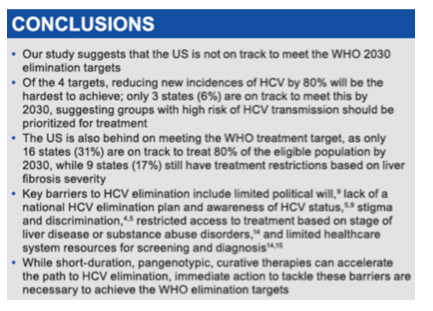| |
HCV Can Be Eliminated - Marginalized, IDUs & homeless can be successfully treated for HCV
|
| |
| |
Jules Levin, NATAP. www.natap.org
HCV Can Be Eliminated: the key is providing colocated HCV treatment & care within substance abuse clinics as depicted in this study below. ...."Our SVR rate (85%) is comparable to those from studies of DAAs in similar populations".
There has been a lack of will & commitment to fund this effort by federal & stare authorities and by Congress. But a few states (only a few) have undertaken increased efforts to increase treatment, even these are not full elimination efforts.

• injection drug users can & are being successfully treated, this study immediately below of erecting treatment program embedded within substance abuse clinics is required - it depicts the key to eliminating HCV which means treatment frameworks for injection drug users. To achieve hepatitis C virus infection (HCV) elimination, a greater proportion of people who inject drugs (PWID) living with HCV need to be diagnosed, treated, and cured.
John Ward (former CDC head of hepatitis & now with Coalition for Global Hepatitis Elimination) said in The Lancet Oct 29 2020:
In 2016, WHO set goals for the elimination of HCV by 2030.
71 million people globally are already living with HCV. Deaths among those infected have sadly mounted to over 500 000 annually.
To curb this epidemic, a safe and effective therapy was needed. In 2014, years of research culminated in the first cure for a chronic viral infection. Anyone infected with HCV are now recommended to receive treatment, saving lives and health-care costs.
However, in 2020, only one in five people infected with HCV are diagnosed, and a smaller fraction is treated and cured.
The barrier to sufficient HCV testing and treatment is no longer on the scientific or public health side. In fact, all the pieces are in place to eliminate HCV, save one: financing.
In the coming decade, 1⋅5 million deaths can be averted by HCV elimination.
Colocated HCV Treatment at Methadone Maintenance in Providence Rhode Island...Road to HCV Elimination - (10/20/20)
Our findings show that people who initiated DAAs in an urban MMP achieved high levels of SVR.
Our SVR rate (85%) is comparable to those from studies of DAAs in similar populations.
EASLTiming of Hepatitis C Elimination in the United States: Estimating the year each state will achieve the World Health Organizations targets - (08/27/20)

EASL Global timing of hepatitis C virus elimination in high-income countries: an updated analysis - (08/27/20)
The USA Ranks last in the world in timing for HCV elimination:

EASL Microelimination & Elimination at EASL 2020 - (09/28/20)
These studies include successful treatment of substance abusers, homeless, migrants, needle exechange users
Colocated HCV Treatment at Methadone Maintenance in Providence Rhode Island...Road to HCV Elimination - (10/20/20)
Our findings show that people who initiated DAAs in an urban MMP achieved high levels of SVR.
Our SVR rate (85%) is comparable to those from studies of DAAs in similar populations.
A systematic review and meta-analysis of international DAA treatment outcomes reports SVR of 87.4% among people with recent IDU and 90.7% among those receiving OAT [2].....Another success of this "real-world" cohort was the low proportion loss to follow-up and patients evaluable for SVR (8.8% of the ITT population). Engagement following DAA therapy is necessary for determining SVR, managing cirrhosis, ongoing HR, routine testing for reinfection, and prompt retreatment [23]. Colocated OAT can improve retention in HCV care [22].
Embedding HCV treatment into services utilized by PWID can facilitate access, as drug-involved populations may face stigma and difficulty navigating traditional health care environments. The advent of DAAs simplifies HCV therapy and enables prescription by a broad range of providers. Delivering all elements of care under 1 roof may be accomplished with colocated HCV and addiction care.
To achieve hepatitis C virus infection (HCV) elimination, a greater proportion of people who inject drugs (PWID) living with HCV need to be diagnosed, treated, and cured. PWID constitute the largest group of persons in the United States infected with HCV and account for most new infections [1]. PWID may be successfully treated with direct-acting antiviral (DAA) agents. Contemporary meta-analyses demonstrate high sustained virologic response (SVR) rates among PWID with or without opioid agonist therapy (OAT; methadone [μ-receptor full agonist] and buprenorphine [μ-receptor partial agonist]) [2, 3]. While national and international guidelines support HCV treatment scale-up for PWID, in the United States, a minority receive treatment. Historically, HCV care has been delivered in specialist settings.
https://mappinghepc.com/maps
| |
| |
| |
|
|
|